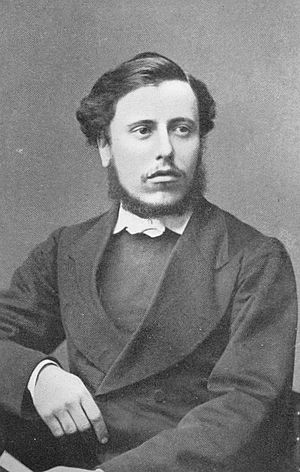William Robertson Smith facts for kids
Quick facts for kids
William Robertson Smith
|
|
|---|---|
 |
|
| Born | 8 November 1846 Keig, Aberdeenshire, Scotland |
| Died | 31 March 1894 (aged 47) Cambridge, England |
| Occupation | Minister of religion, theologian, Semitic scholar |
| Alma mater | New College, Edinburgh |
| Notable works | Religion of the Semites |
William Robertson Smith (born November 8, 1846 – died March 31, 1894) was a Scottish expert on the Middle East and the Old Testament (the first part of the Christian Bible). He was also a professor and a minister in the Free Church of Scotland. He helped edit the famous Encyclopædia Britannica and wrote for the Encyclopaedia Biblica. He is especially known for his book Religion of the Semites, which is a very important work in studying different religions.
Contents
Life and Career
William Robertson Smith was born in Keig, a place in Aberdeenshire, Scotland. He was the oldest son of Reverend Dr. William Pirie Smith. From a young age, William showed he was very smart.
He started studying at Aberdeen University when he was only fifteen. Later, in 1866, he moved to New College in Edinburgh to train to become a minister. After finishing his studies, he became a professor of Hebrew at the Aberdeen Free Church College in 1870.
In 1875, Smith wrote several important articles about religion for the ninth edition of the Encyclopædia Britannica. These articles caused a big stir because they looked at religious topics in a new way. He did not always treat the Bible as if every word was literally true. This led to a public discussion and even a "heresy trial" in the Free Church of Scotland.
Because of this controversy, he lost his teaching job at Aberdeen Free Church College in 1881. However, he soon got a new job at the University of Cambridge as a reader in Arabic. At Cambridge, he became the University Librarian and a Professor of Arabic. During this time, he wrote two important books: The Old Testament in the Jewish Church (1881) and The Prophets of Israel (1882). These books were written to help regular people understand complex religious ideas.
In 1887, Smith became the editor of the Encyclopædia Britannica. In 1889, he wrote his most famous book, Religion of the Semites. This book explored the ancient religious life of Jewish people and was one of the first to use ideas from sociology to understand religion. He held the title of 'Sir Thomas Adams Professor of Arabic' until his death.
William Robertson Smith passed away from tuberculosis on March 31, 1894, at Christ's College, Cambridge. He was buried with his parents in the churchyard at Keig.
Published Works
William Robertson Smith wrote many books and articles. Here are some of his most important works:
The Old Testament in the Jewish Church
This book, published in 1881, was based on lectures Smith gave. He talked about how to study the Old Testament using a method called higher criticism. This method looks at the Bible's history and how it was written, rather than just taking every word literally.
Smith explained that understanding the Bible's history helps people connect with God's actions in the past. He showed that some parts of the Bible, especially the early books, seemed to combine different stories. He also suggested that some laws in the Pentateuch (the first five books of the Bible) were written much later than the time of Moses.
The Prophets of Israel
Published in 1882, this book looked at the prophets of ancient Israel. Smith compared them to religious leaders in other ancient nations. He showed how Israel's prophets focused on justice and God's will, which was different from some other ancient practices.
He discussed famous prophets like Amos, Hosea, and Isaiah. Smith believed that studying the prophets' messages helped show how the Hebrew religion grew over time. He argued that understanding the Bible through historical study actually made the religion stronger.
Kinship and Marriage in Early Arabia
In this 1885 book, Smith explored how families and marriages worked in pre-Islamic Arabia. He looked at how kinship (family ties) and marriage customs changed over time. He discussed ideas like totemism (where groups identify with an animal or plant) and how family groups developed.
Smith's ideas in this book were based on new studies of ancient cultures at the time. While some of his specific theories are not widely accepted by scholars today, the book was important for starting new ways of thinking about ancient societies.
The Religion of the Semites
This famous book, first published in 1889, tried to understand the common religious practices of ancient Semitic peoples. These groups lived in places like Mesopotamia, Syria, Phoenicia, Israel, and Arabia. Smith's goal was to show the historical background for the early writings of the Bible.
He discussed holy places, like sacred trees and stones, and the idea of sacrifices. One of his ideas was about "communal sacrifice," where a group would share a meal of a sacred animal to feel closer to their god. This book was very influential and shaped how many later scholars studied religion.
Other Writings
Besides his major books, William Robertson Smith wrote many articles for the Encyclopædia Britannica. He also published various essays and lectures on scientific topics, early religious ideas, and his studies of Arabian culture.
Family
William Robertson Smith's younger brother was Charles Michie Smith, a well-known astronomer.
See also
 In Spanish: William Robertson Smith para niños
In Spanish: William Robertson Smith para niños


